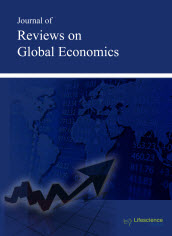jrge
Abstract - Brics’ Foreign Debt Burden and its Impact on Core Institutional Basis
|
|
Abstract: Creation of a multipolar international economy and economic relations is accompanied by shifting gravity centers of international finances, redistribution of positions on the global market for financial services in favor of large emerging countries and countries with transitional economies. This post crisis period triggered serious problems related to international capital inflows and outflows at the BRICS states. This is all due to a slow recovery of developed countries; a high probability of a full-scale debt crisis in some E.U. states; mounting uncertainties following financial reforms in some states, etc. But raising debt as an important way to finance speedy economic growth and import of technologies to the BRICS countries make their financial systems more vulnerable to exogenous stresses and shocks, which result in an unreasonable firming of national currencies. In our research, we have identified the risks and misbalances of global development, which affect BRICS, evaluated the influence of foreign debt and singled out the key growth trends. We have revealed the importance of the New Development Bank development, which will help solve urgent problems of its participants connected with their growing role in international economic relations: the creation of a regional financing mechanism as well as a core institutional basis to represent BRICS’ interests in the global financial structure and to become the missing link in interaction with global financial institutions. Keywords: Budget policy, state debt, tax burden on the economy, financial system of the state, macroeconomics, BRICS members. |
Abstract - The Impact of the Central Bank Key Rate and Commercial Banks Credit Rates on Creating and Maintaining of a Favorable Investment Climate in the Country
|
|
Abstract: Paper is devoted to study of the impact of the Central Bank key rate and commercial banks credit rates on creating and maintaining of a favorable investment climate in the country. Within the framework of modern investment models created by the authors, the dependence of the efficiency of investments on the level of debt financing within a wide range of values of equity costs and debt capital costs under different project terms (long –term projects as well as projects of arbitrary duration) and different investment profitability coefficients b is investigated. The effectiveness of investments is determined by Net Present Value, NPV. The study is conducted within the framework of investment models with debt repayment at the end of the project term. It is found that NPV depends practically linearly on leverage level L, increasing or decreasing depending on profitability coefficient b and credit rate values kd. The cut off credit rate values kd*, separating the range of increasing NPV(L) from range of decreasing NPV(L), are determined. The Central Bank should keep its key rate at the level which allow commercial banks keep their credit rates below the cut off credit rate kd* values in order to create and maintain a favorable investment climate in the country. Keywords: Central Bank, commercial banks, a favorable investment climate, credit rate, key rate, profitability coefficient. |
Abstract - Fintech Ecosystem and Landscape in Russia
|
|
Abstract: Fintech is today not only a hot mass media discussion of the future of the financial sector, but also real projects that change banking and financial services. The paper describes features and characteristics of contemporary Russian fintech landscape and ecosystem. The examples of innovative financial services in Russia, including online banking and accounting, new payments and transfers services, platforms for crowdfunding and peer-to-peer lending, blockchain initiatives, etc. are discussed. It is shown that fintech initiatives have not yet led to a radical transformation of the financial sector in Russia because participants of the fintech ecosystem have different points of view on fintech. Russian banks are now developing fintech initiatives within themselves, encouraging technology companies and fintech startups to focus their efforts on innovations that are aimed at improving processes, rather than opening new markets. The Government directs the main efforts to initiatives related to regulation of cryptocurrencies circulation and to introduction of blockchain in regtech and cybersecurity. Customers are interested in new and more convenient functionality in mobile applications, and they are waiting for new value propositions, including fast international money transfers, roboadvising, personal financial management, peer-to-peer lending. Keywords: Digital banking, fintech, fintech landscape, fintech infrastructure, fintech business models. |
Abstract - Components of Financial Stability of Credit Institutions: A New Perspective and New Horizons
|
|
Abstract: The article discloses a financial model characterizing the stability of credit institutions. In addition to the traditional quantitative indicators of the bank's activities, such as capital, assets, profit of the credit institution and others, relative indicators are of particular importance for assessing the effectiveness of banking activities. It is necessary to evaluate both quantitative and qualitative indicators of the activity of credit institutions, the synergy of which will enable them to identify the components of financial soundness and their assessment. An assessment of the financial stability of an individual credit institution is possible only based on the results of a comparison with the industry average components of financial stability. Particular attention is paid to such a component of assessing the financial stability of banks, as the effectiveness of the settlement of troubled debts. The authors of the article developed an alternative system for choosing a strategy for resolving the problem debt of credit institutions based on the qualimetric model. Keywords: Finance, bank, financial stability. |






















